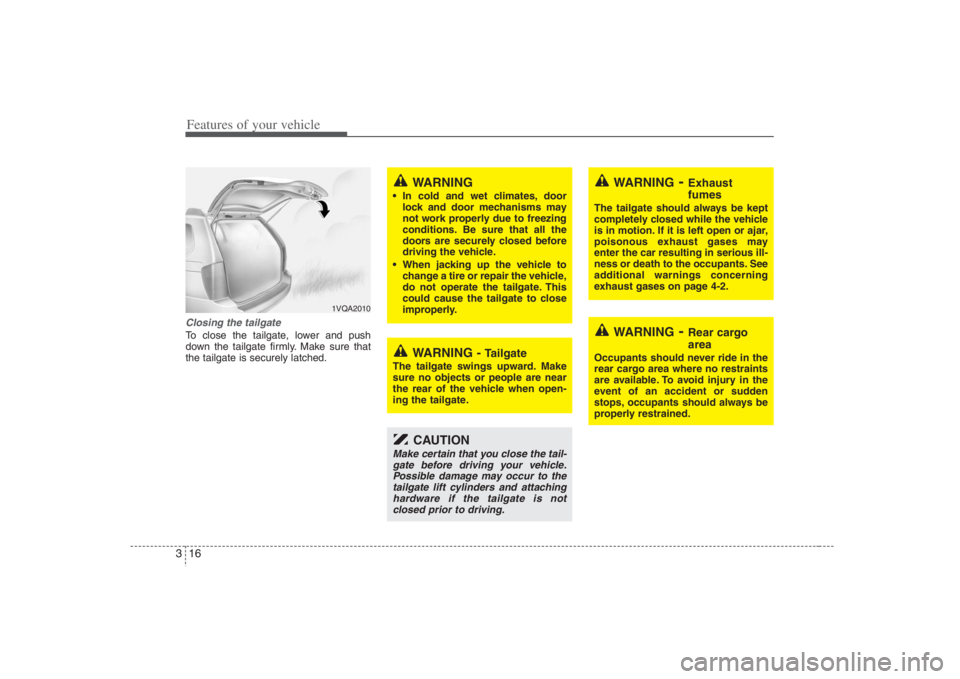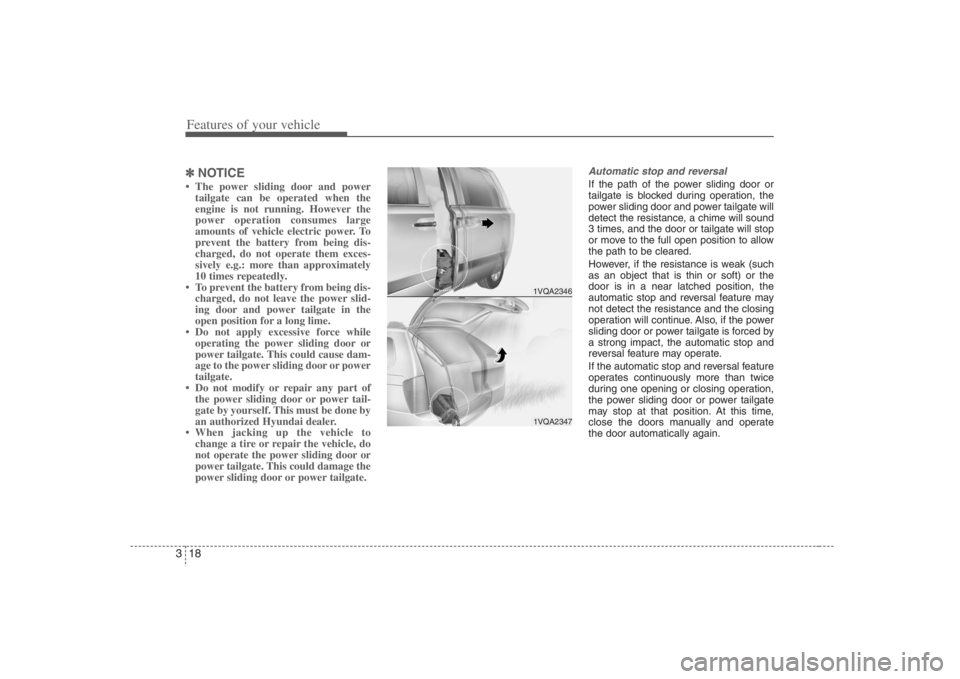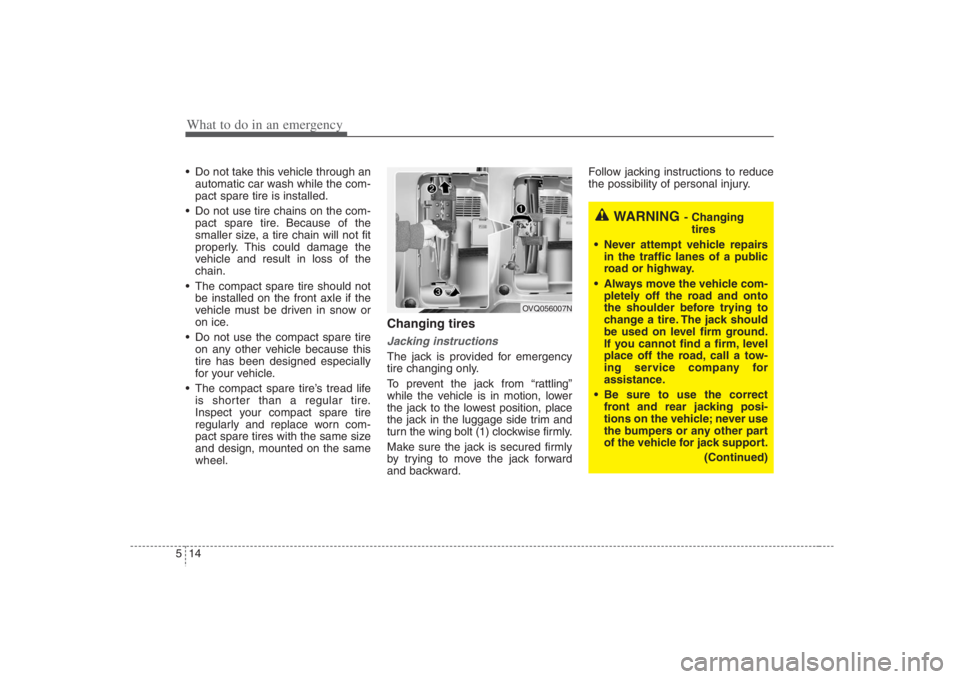Page 32 of 393

Features of your vehicle16 3Closing the tailgateTo close the tailgate, lower and push
down the tailgate firmly. Make sure that
the tailgate is securely latched.
1VQA2010
WARNING -
Tailgate
The tailgate swings upward. Make
sure no objects or people are near
the rear of the vehicle when open-
ing the tailgate.
CAUTION
Make certain that you close the tail-
gate before driving your vehicle.
Possible damage may occur to the
tailgate lift cylinders and attaching
hardware if the tailgate is not
closed prior to driving.
WARNING
- Exhaust
fumes
The tailgate should always be kept
completely closed while the vehicle
is in motion. If it is left open or ajar,
poisonous exhaust gases may
enter the car resulting in serious ill-
ness or death to the occupants. See
additional warnings concerning
exhaust gases on page 4-2.
WARNING
- Rear cargo
area
Occupants should never ride in the
rear cargo area where no restraints
are available. To avoid injury in the
event of an accident or sudden
stops, occupants should always be
properly restrained.
WARNING
In cold and wet climates, door
lock and door mechanisms may
not work properly due to freezing
conditions. Be sure that all the
doors are securely closed before
driving the vehicle.
When jacking up the vehicle to
change a tire or repair the vehicle,
do not operate the tailgate. This
could cause the tailgate to close
improperly.
Page 34 of 393

Features of your vehicle18 3✽
✽
NOTICE• The power sliding door and power
tailgate can be operated when the
engine is not running. However the
power operation consumes large
amounts of vehicle electric power. To
prevent the battery from being dis-
charged, do not operate them exces-
sively e.g.: more than approximately
10 times repeatedly.
• To prevent the battery from being dis-
charged, do not leave the power slid-
ing door and power tailgate in the
open position for a long lime.
• Do not apply excessive force while
operating the power sliding door or
power tailgate. This could cause dam-
age to the power sliding door or power
tailgate.
• Do not modify or repair any part of
the power sliding door or power tail-
gate by yourself. This must be done by
an authorized Hyundai dealer.
• When jacking up the vehicle to
change a tire or repair the vehicle, do
not operate the power sliding door or
power tailgate. This could damage the
power sliding door or power tailgate.
Automatic stop and reversalIf the path of the power sliding door or
tailgate is blocked during operation, the
power sliding door and power tailgate will
detect the resistance, a chime will sound
3 times, and the door or tailgate will stop
or move to the full open position to allow
the path to be cleared.
However, if the resistance is weak (such
as an object that is thin or soft) or the
door is in a near latched position, the
automatic stop and reversal feature may
not detect the resistance and the closing
operation will continue. Also, if the power
sliding door or power tailgate is forced by
a strong impact, the automatic stop and
reversal feature may operate.
If the automatic stop and reversal feature
operates continuously more than twice
during one opening or closing operation,
the power sliding door or power tailgate
may stop at that position. At this time,
close the doors manually and operate
the door automatically again.
1VQA23461VQA2347
Page 300 of 393

What to do in an emergency14 5 Do not take this vehicle through an
automatic car wash while the com-
pact spare tire is installed.
Do not use tire chains on the com-
pact spare tire. Because of the
smaller size, a tire chain will not fit
properly. This could damage the
vehicle and result in loss of the
chain.
The compact spare tire should not
be installed on the front axle if the
vehicle must be driven in snow or
on ice.
Do not use the compact spare tire
on any other vehicle because this
tire has been designed especially
for your vehicle.
The compact spare tire’s tread life
is shorter than a regular tire.
Inspect your compact spare tire
regularly and replace worn com-
pact spare tires with the same size
and design, mounted on the same
wheel.
Changing tires Jacking instructions The jack is provided for emergency
tire changing only.
To prevent the jack from “rattling”
while the vehicle is in motion, lower
the jack to the lowest position, place
the jack in the luggage side trim and
turn the wing bolt (1) clockwise firmly.
Make sure the jack is secured firmly
by trying to move the jack forward
and backward.Follow jacking instructions to reduce
the possibility of personal injury.
WARNING
- Changing
tires
Never attempt vehicle repairs
in the traffic lanes of a public
road or highway.
Always move the vehicle com-
pletely off the road and onto
the shoulder before trying to
change a tire. The jack should
be used on level firm ground.
If you cannot find a firm, level
place off the road, call a tow-
ing service company for
assistance.
Be sure to use the correct
front and rear jacking posi-
tions on the vehicle; never use
the bumpers or any other part
of the vehicle for jack support.
(Continued)
OVQ056007N
Page 302 of 393
What to do in an emergency16 5
6. Loosen the wheel lug nuts coun-
terclockwise one turn each, but do
not remove any nut until the tire
has been raised off the ground.7. Place the jack at the front or rear
jacking position closest to the tire
you are changing. Place the jack
at the designated locations under
the frame. The jacking positions
are plates welded to the frame
with two tabs and a raised dot to
index with the jack.
WARNING
- Jack location
To reduce the possibility of
injury, be sure to use only the
jack provided with the vehicle
and in the correct jack position;
never use any other part of the
vehicle for jack support.
OEP056027
OEP056028
WARNING
- Changing a tire
To prevent vehicle movement
while changing a tire, always
set the parking brake fully, and
always block the wheel diago-
nally opposite the wheel being
changed.
We recommend that the
wheels of the vehicle be
chocked, and that no person
remain in a vehicle that is
being jacked.